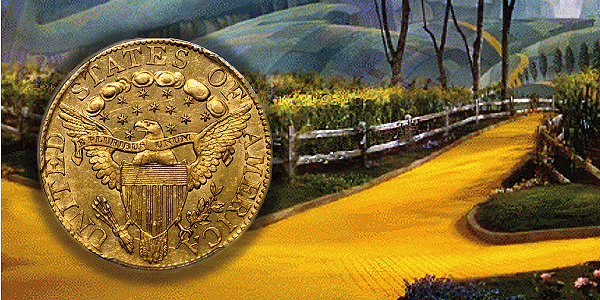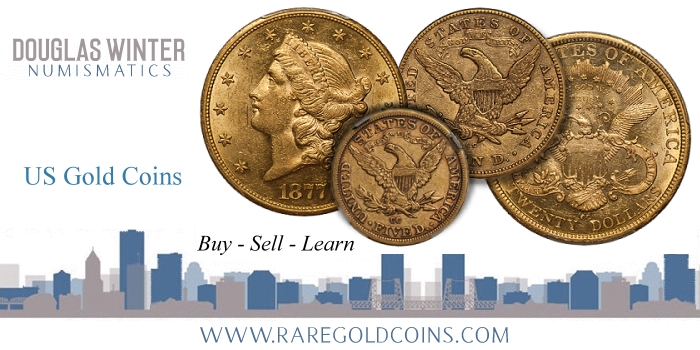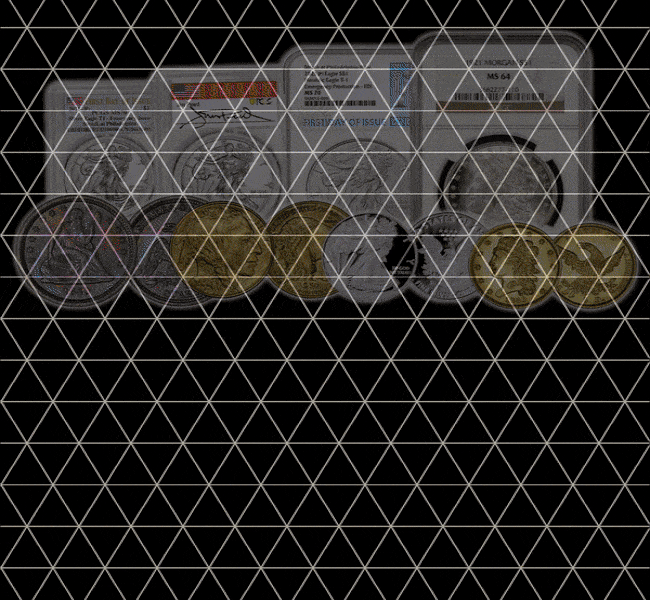
By Doug Winter – RareGoldcoins.com
CoinWeek Content Partner ……
Even if you are an ultra-specialized collector of U.S. gold coins–let’s say with an emphasis on Type One double eagles or Dahlonega half eagles–there are still specific important gold types which you might find compelling. A collector recently asked me for a list of a dozen gold issues which fell out of his range of specialization but which I felt might make good additions to his set. I stopped at 15, and could have EASILY doubled the size of this list; especially if I wasn’t constrained by budget and/or availability.
I’ve tried to base this list on practical concerns. Every collector would like to own a Gem 1795 half eagle or a choice 1808 quarter eagle. But these two issues—and many more which might have appeared on this list—are expensive and difficult to obtain. So, I stayed with coins which were for the most part under $10,000, and which could be found without considerable effort.
1. A Charlotte or Dahlonega Gold Dollar
Even if you collect 20th-century American gold in high grades, the chances are still good that you find the southern branch mint issues fascinating. There is no better way to dip your toe in the water than to purchase a nice quality gold dollar from Charlotte or Dahlonega.
I’d suggest that you take the plunge with a common date Type One issue. The two best candidates are the 1849-D and 1851-C dollars, as these are the two most common gold dollars from their respective mints.
If you are on a limited budget, you can still purchase a very nice Extremely Fine example of either issue for $1,500-2,000. If you double this amount, you can purchase a choice About Uncirculated example or even a low-end Uncirculated. I’d suggest sticking with an AU58 with an above average strike, choice surfaces, and natural color.
2. A “Standalone” Type Two Gold Dollar
I have recently written about “standalone” issues, and perhaps the most interesting selection of standalone issues falls in the Type Two gold dollars made in 1855 and 1856. The two most affordable are the 1855-O and the 1856-S.
The 1855-O is a very affordable issue in Extremely Fine grades, and I have recently sold some nice pieces in the $1,250-1,750 price range. A Choice About Uncirculated 1855-O gold dollar can be bought, with a little searching, for around double the price of an EF.
If I had to select one of the two recommended standalone gold dollars from this list, I would choose the 1856-S and I’d opt for a choice, lustrous AU55 to AU58 example. These are not easy to find but they aren’t all that rare and I typically sell them for $3,000 to $5,000+, depending on quality.
3. A Classic Head Quarter Eagle
I considered selecting an early quarter eagle (pre-1808), but these are likely too expensive for the purposes of this list. Instead, I reconsidered and selected a Classic Head quarter eagle as this gives a collector a chance to own an “early” date at a much more affordable price. For this list, I’d suggest a Choice About Uncirculated common date from Philadelphia, struck from 1834 to 1839.
By far the most common date of this type is the 1834, so for the sake of “spicing up” this collection, let’s avoid it and go with a scarcer issue such as the 1837 or 1838. Let’s also avoid the typical bright, processed coins in AU55 and AU58 holders and look for a dark, crusty piece which has some luster remaining over choice, unmarked surfaces. Such a coin will be available in the $1,500-3,000 range and it represents, in my opinion an excellent value.
4. A Superb Gem (MS66 or MS67) Liberty Head Quarter Eagle
This choice might cause some controversy as it isn’t a really rare or unusual coin. But if you specialize in a series where EF and AU coins are the norm, the thought of owning a monster grade coin is pretty intriguing.
MS66 common date Liberty Head quarter eagles are far from rare but they are pretty and they are great value right now; I recently sold a small group of hand selected PCGS/CAC MS66’s for $1,650 each. If you are willing to buy non-CAC pieces (not advised in this instance) your price is reduced to an average of $1,250 per coin.
Common dates in MS67 are still affordable as well, and the price jump to the next grade up makes them a much better value than MS68 coins. PCGS MS67 common dates currently sell for around $3,000 and for an extra $500-1000 you can buy one with a CAC sticker.
5. A Nice Three Dollar Gold Piece
Not many collectors seem to want to specialize in this odd denomination, but this doesn’t mean that a Charlotte half eagle specialist wouldn’t mind owning a nice common date to slightly better date Three Dollar gold piece in MS63 to MS64.
The three most common dates of this type are 1854, 1878, and 1889, so let’s eliminate these and focus on slightly better dates like the 1855, 1856, 1879, 1880, and 1888. A solid for the grade MS63 is currently valued at around $5,000-6,000. For around $7,000 an even scarcer date can be obtained.
Many of these dates are rare in MS64, so for this grade let’s turn our focus on a nice CAC approved PCGS MS64 common date. The 1878 is currently priced at around $5,000 and for $500 more, you can own an MS64+ with CAC approval. Cheap!!!
6. An “Early” (pre-1813) Half Eagle
You might not agree with some of the choices on this list, but I think just about every collector would like to own a nice piece of early gold. Early quarter eagles are expensive while early eagles are limited in scope and are even more expensive. This leaves early half eagles, specifically the Bust Right and Capped Bust Left types.
Bust Right half eagles were made from 1795 through 1807. For most type collectors, the issues made from 1800 to 1807 will be the most available and affordable. These dates are not typically seen in grades below AU50 and I’d personally recommend a bit of a splurge for a special looking AU55 to AU58 in the $10,000-12,500 range.
After you buy a Bust Right half eagle, your taste for early gold may not be sated. I’d suggest a similar grade/quality Capped Bust Left issue, dated from 1807 to 1812. This type is priced similarly to the Bust Right and it should be a hair easier to locate.
7. A No Motto New Orleans Half Eagle
Owning a neat New Orleans (or a Charlotte or Dahlonega) No Motto half eagle is a virtual prerequisite for every collector of United States gold coinage.
The New Orleans mint made No Motto half eagles, with interruptions, from 1840 through 1857. Only two of these dates are rare (1842-O and 1847-O) while two others are what I would regard as semi-common (1844-O and 1854-O). Thus, I would choose a scarcer but available date such as the 1843-O, 1845-O, 1846-O, or 1851-O. A nice Extremely Fine example can be bought for $2,000-2,5000 ,while a choice About Uncirculated will be available in the $4,000-6,000 range.
Say you want to supplement this choice with a Charlotte or Dahlonega half eagle. There are many dates to choose from and these will run around $2,000-3,000 for a nice Extremely Fine, to $4,000-6,000+ for a very nice About Uncirculated. With any No Motto half eagle from the Southern branch mints, I’d select a coin with deep, original color and choice, relatively unabraded surfaces.
8. A Civil War Half Eagle
Coins from the Civil War years (1861-1865) are extremely popular with collectors and they represent an interesting addition to any specialized United States gold coin set. I selected a half eagle to represent this type, but a collector can just as easily choose an eagle or a double eagle.
Civil War half eagles were made at the Philadelphia and San Francisco mints in 1861 through 1865, and at the Charlotte and Dahlonega mints in 1861 only.
The 1861-D would be the ultimate coin for this set but it is rare and expensive. So, I’d suggest a nice 1861 half eagle from the Philadelphia mint. This is not an especially rare coin until you get up to the MS64 and higher grades. So, this means that a nice MS62 can be bought for $3,000-4,000 while an MS63 will cost in the $5,000-6,000 range.
9. A High Quality Indian Head Half eagle
I’m not a 20th-century gold aficionado. I tend to like 18th- and 19th-century issues, and prefer absolute rarity to condition rarity. That said, I have always loved the design of the Indian Head half eagle and I’ve actually helped build some of the finest sets of this series ever assembled.
Right now, prices for higher grade Indian Head half eagles are in the proverbial toilet for a number of reasons. Suffice to say, this is an excellent time for the collector to obtain a really nice MS64 or MS65 Indian Head half eagle at really fair levels.
I’d strongly suggest looking for a coin with CAC approval. A common date in MS64 with a CAC sticker is currently available for $2,000-2,500, while an MS65 with a CAC sticker will run around $10,000-12,000. These levels seem reasonable to me although it certainly possible they could drop even more in the coming months.
10. An “Early” (pre-1804) Eagle
What I said earlier about every collector wanting to own a piece of early gold is especially true for a large-size coin like a Heraldic Eagle reverse 10-dollar gold piece. These were made from 1797 to 1804 and they are very popular with date and type collectors.
That’s the good news. The bad news is that these are expensive coins and that they seldom are found in grades below About Uncirculated. The date that I think makes most sense for a type coin is the common 1799 because of its 18th century issuance.
A problem-free reasonably choice AU example of a 1799 eagle currently costs around $20,000-25,000. A Choice AU with good original color and a CAC sticker is very hard to find and will cost in excess of $27,500-30,000.
Obviously, the price factor of this type means that only a select handful of collectors can afford an early eagle, but those who are able to will surely regard this as one of the highlights of their non-core collection.
11. A Nice No Motto Eagle
No Motto eagles were struck at the Philadelphia mint from 1838 through 1865, and at the San Francisco mint from 1854 through 1866. These issues range from common to very rare and they are of interest to collectors of various types of United States gold coinage.
Prices for No Motto eagles range from around $1,000 for a common date P Mint issue in mid-AU grades up into five figures. For the purposes of the set we are discussing in this article, I’d stick with a Philadelphia issue from the 1840’s or 1850’s in Choice AU58. A number of different dates can be bought in the $1,500 to $2,500 range.
If the collector wants to shop for an Uncirculated No Motto eagle, locating a coin in MS61 or even MS62 will not present much of a challenge (although finding a choice, original coin with good color will prove much more difficult). A budget of around $5,000 will be enough for a neat, conditionally scarce No Motto eagle.
12. An SS Central America Double Eagle
By now, virtually every collector knows the story of the SS Central America (SSCA) treasure. Many collectors choose to add a coin from this shipwreck to their non-core collection and with good reason. These coins not only have a great back story, they are big and beautiful.
A strong secondary market has evolved for SSCA gold coins so for most non-specialists, the right issue to focus on is the common 1857-S Double Eagle. I suggest either an AU58 (generally available in the $5,500-6,500 range) or an MS64 (generally available in the $8,500-9,500 range).
There are thousands of potential SSCA double eagles to choose from, so it is important for the collector to be selective. Look for a coin which is bright and free of residue. Also, look for a piece which is housed in the original PCGS gold foil insert holder as these are more desirable than one which has clearly been upgraded.
13. A Carson City Double Eagle
The Carson City mint struck silver and gold coins from 1870 through 1893. Double eagles were the largest gold coins struck by this facility and they are very popular with all sorts of collectors.
For this set, I’d suggest looking for a common date from the 1880’s or the early 1890’s in About Uncirculated grades. These have become fairly expensive in recent years but they are in great demand. As an example, a nice PCGS/CAC AU55 common date will cost $5,500-6,500 while a similar coin graded AU58 will run a few thousand dollars more.
To my way of thinking, all collections of US gold coinage should contain at least one Carson City double eagle and maybe a single example of a half eagle and eagle from this mint as well.
14. A High Relief Double Eagle
This is probably the least controversial choice of the 15 coins on this list. I freely admit that High Reliefs are considerably overvalued relative to their actual rarity, BUT they are incredibly popular. This has made them a good price performer over the last decade.
I personally like this issue due to its great backstory and its incontestably beautiful design. For most collectors, a nice MS63 or MS64 will suffice. Look to spend in the $20,000-25,000 range on the former and $30,000-35,000 on the latter.
A few buying tips for High Reliefs. Always look at the breast and knee of Liberty on the obverse as these are the areas which are the prime focus for wear. A High Relief should have pleasing, well-defined color with lemon-yellow and greenish-gold hues. Avoid coins which are too bright or too “ticky,” and always check the rims to make sure there aren’t any hidden nicks or bumps.
15. A Piece of Proof Gold
For the final selection on this list, I’ve chosen what is a “dream coin” for many gold collectors: a piece of Proof gold. Most Proof gold is rare and expensive but there are some affordable options which not every collector may be aware of.
Gold Dollars and Quarter Eagles in Proof 63 and Proof 64 grades are relatively affordable and some genuinely nice (and legitimately scarce) coins can be had for under $10,000. I would suggest that the collector avoid very low end or Impaired Proof examples of rare dates, or higher denominations as these tend to be aesthetically unappealing and may prove difficult to resell.
So there you have my List of 15. Which coins do you own and which do you aspire to own? Which would you delete from this list and what would you replace these with? Your comments are appreciated.
* * *
About Doug Winter
 Doug has spent much of his life in the field of numismatics; beginning collecting coins at the age of seven, and by the time he was 10 years old, buying and selling coins at conventions in the New York City area.
Doug has spent much of his life in the field of numismatics; beginning collecting coins at the age of seven, and by the time he was 10 years old, buying and selling coins at conventions in the New York City area.
In 1989, he founded Douglas Winter Numismatics, and his firm specializes in buying and selling choice and rare US Gold coins, especially US gold coins and all branch mint material.
Recognized as one of the leading specialized numismatic firms, Doug is an award-winning author of over a dozen numismatic books and the recognized expert on US Gold. His knowledge and an exceptional eye for properly graded and original coins has made him one of the most respected figures in the numismatic community and a sought after dealer by collectors and investors looking for professional personalized service, a select inventory of impeccable quality and fair and honest pricing. Doug is also a major buyer of all US coins and is always looking to purchase collections both large and small. He can be reached at (214) 675-9897.
Doug has been a contributor to the Guidebook of United States Coins (also known as the “Redbook”) since 1983, Walter Breen’s Encyclopedia of United States and Colonial Coins, Q. David Bowers’ Encyclopedia of United States Silver Dollars and Andrew Pollock’s United States Pattern and Related Issues
In addition, he has authored 13 books on US Gold coins including:
- Gold Coins of the New Orleans Mint: 1839-1909
- Gold Coins of the Carson City Mint: 1870 – 1893
- Gold Coins of the Charlotte Mint: 1838-1861
- Gold Coins of the Dahlonega Mint 1838-1861
- The United States $3 Gold Pieces 1854-1889
- Carson City Gold Coinage 1870-1893: A Rarity and Condition Census Update
- An Insider’s Guide to Collecting Type One Double Eagles
- The Connoisseur’s Guide to United States Gold Coins
- A Collector’s Guide To Indian Head Quarter Eagles
- The Acadiana Collection of New Orleans Coinage
- Type Three Double Eagles, 1877-1907: A Numismatic History and Analysis
- Gold Coins of the Dahlonega Mint, 1838-1861: A Numismatic History and Analysis
- Type Two Double Eagles, 1866-1876: A Numismatic History and Analysis
Finally, Doug is a member of virtually every major numismatic organization, professional trade group and major coin association in the US.
[wpebayads]





